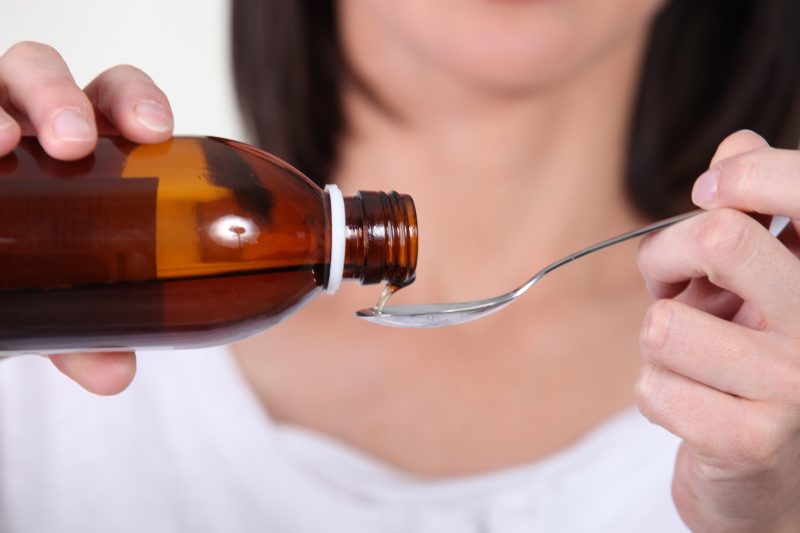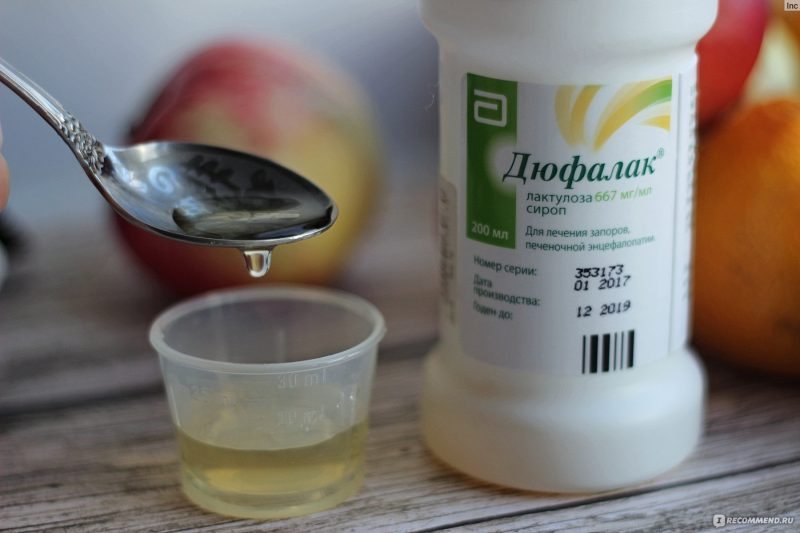Lactulose syrup is a soft and safe medication for all age groups with a laxative effect. It contains the active substance as a liquid oligosaccharide and prebiotic lactulose, which is produced from lactose (milk sugar) in the process of milk processing. The medication is approved for use in pediatrics from infancy.
Material Content:
Lactulose syrup - composition and form of release
Lactulose syrup looks like a viscous translucent sweet liquid from light white to brown-beige.

- Active substance: lactulose, the amount of which in 1 ml of syrup is 667 mg.
- Additional substances: citric acid, distilled water.
- Release form - plastic bottles (Russia, Germany) with a volume of 1000, 200, 500 ml or colored glass bottles (manufactured in Serbia and Montenegro) with the same volume of a medicinal product.
For each bottle in a cardboard box put a special measuring cup and instructions.
Indications for use

Lactulose syrup is indicated for patients with the following pathological conditions and diseases:
- frequent and long-term constipation of a different nature;
- hepatic encephalopathy, which is characterized by severe lesions of the central nervous system (from mental disorders to coma), due to a pronounced deterioration in the functioning of the liver;
- salmonellosis or carriage of salmonella, excluding generalized forms (the spread of pathogens throughout the body through the bloodstream);
- food poisoning;
- digestive disorders due to active putrefactive processes in children from infancy;
- hemorrhoids and cracks in the anal canal (severe pain during bowel release);
- imbalance between the types of intestinal bacterial flora (dysbiosis);
- weakening of intestinal motility after radiation, antibiotic and chemical therapy, as well as after surgical interventions in the anus and rectum;
- liver disease, cirrhosis.
The drug is allowed to treat:
- full-term infants older than 6 weeks, premature infants older than 8 to 10 weeks (or as directed by the pediatrician);
- pregnant women and breastfeeding babies;
- older people, patients after surgery on hemorrhoids.
Medicinal action

Long-term practical studies have proven that lactulose syrup has a series of health benefits:
- Acts as a mild laxative. Through biochemical processes, lactulose leads to the retention of fluid in the intestine, increasing the moisture and viscosity of feces and increasing their volume. Under the influence of the active substance, positive changes occur in the composition of the intestinal flora due to the intensification of the process of reproduction of bifidobacteria and lactobacilli, which break down carbohydrates. This leads to easy acidification of fecal matter, which stimulates the intestinal motor activity (peristalsis).
Compared to other laxatives, which stimulate intestinal motility and stimulate chemoreceptors, lactulose syrup does not irritate the mucous membrane and muscle fibers. Therefore, a pharmacological product with a fairly long-term intake (up to 4 months) does not cause as much addiction as other drugs, and does not lead to the appearance of the "lazy intestine" syndrome. - Eliminates liver poisoning with encephalopathy. Lactulose today is considered one of the most effective means in the treatment of hepatogenic encephalopathy. It lowers the amount of ammonia in the blood, which is produced in the intestine as a product of putrefactive bacteria and, when it enters the brain, acts on it as a poisonous substance. Lactulose syrup reduces the severity of liver and brain poisoning with toxins and reduces the neuropsychic manifestations of encephalopathy, improving the condition of patients and normalizing brain activity.
- It has a prebiotic effect on the digestive organs. The therapeutic and preventive qualities of the syrup are explained by the ability of lactulose to reach the large intestine without being subjected to enzyme treatment. Here, it selectively activates the growth of its own beneficial normoflora (lacto- and bifidobacteria), which has a positive effect on the body.
- Supports anti-infection protection. The drug suppresses the aggression of many harmful microorganisms, including shigella, clostridia, rotaviruses, yersinia, salmonella, and various bacteroids. Increases the production of beneficial bacteria that produce enzymes that activate immune functions.
- It removes poisons, bacterial toxins, enzymes and metabolites harmful to the body (intermediate substances in metabolic processes).
- Stimulates the production of bile, improves the functioning of the liver, gall bladder.
- It inhibits the growth and inhibits the activity of Salmonella (the causative agent of intestinal infection).
- Normalizes liver function in cirrhosis. The properties of lactulose to resist the aggression of viruses and pathogenic bacteria and inhibit the activity of toxic substances poisoning the liver, provide an improvement in the condition of patients with cirrhosis. This occurs due to the activation of the intercellular component of the immune system, which is inhibited during cirrhosis.
- Improves bone density in osteoporosis.The absorption of calcium in the small intestine increases with the use of lactulose by improving its solubility, and without increasing the excretion of calcium in the urine. This helps strengthen bones in people prone to osteoporosis, including postmenopausal women. The speed and quality of bone restoration after fractures also improves.
- Provides protection of beneficial microflora from the effects of antibacterial drugs.
- Suppresses cancer processes. A number of studies prove the anticarcinogenic effect of lactulose, which is explained by an increase in protective functions through the activity of bifidobacteria.
The therapeutic effects of the syrup are manifested without leading to the absorption of minerals and vitamins from the digestive tract. The active substance practically does not enter the blood without having a general effect on the body.
Instructions for use of lactulose syrup
Typically, a therapist or gastroenterologist prescribes a dose of syrup, taking into account the disease, condition and age of the patient. If there are no special purposes, the application scheme is used according to medical instructions.

Features of the reception:
- It is allowed to drink syrup with juice (preferably carrot, pear, peach), milk, water.
- During syrup therapy, it is advisable to drink more liquid (1.5 - 2.5 liters per day for adults), which is always recommended when taking laxatives.
- It is recommended to treat constipation with lactulose syrup in courses of 10 to 12 days with interruptions of the same duration (at least 10 to 14 days). With long-term use without intervals, the intestine gradually adapts to the daily intake of the drug, which reduces its effect and forces it to increase the dose to achieve a laxative effect.
For adults
Lactulose syrup for adult patients is prescribed for various pathologies according to the above indications.

Basic dosage regimen:
- With constipation, the standard starting dose per day for the first 3 days is 30 to 45 ml of syrup. It can be taken once before breakfast or divided into 2 - 3 doses of 15 ml before meals. After the manifestation of a laxative effect, the daily volume of the syrup is reduced to a maintenance dose of 15 to 20 ml. Instead of reducing the dose, it is allowed to reduce the frequency of use up to 3 times in 7 days. With persistent constipation, as directed by a therapist, the daily dose of the drug may be increased to 60 ml.
- With hepatic encephalopathy, a medication is prescribed three times a day, 30-50 ml with a possible increase in syrup volume to a maximum dose of 190 ml. Excess volume of medication can cause diarrhea, so the dosage is limited taking into account that the number of bowel movements per day does not exceed 2 - 3 times. In the case of an unsatisfactory manifestation of the therapeutic effect, it is advisable to combine the use of syrup and Neomycin, in order to mutually enhance the therapeutic effect.
- If salmonellosis is diagnosed, the drug is drunk three times a day in 15 ml for 10 to 12 days. After a break of 7 to 8 days, treatment is continued according to the same scheme. According to the testimony, another course is possible with an increase in a single dosage to 30 ml. Salmonella-carrying patients use the drug for up to 3 weeks with a single daily dosage of 20 ml.
If the syrup is used for a long time (longer than 5 months), especially elderly patients, it is necessary to periodically check the blood levels of chlorine, potassium, carbon dioxide.
For children
Lactulose syrup for children is considered a harmless and mildly acting laxative and prebiotic. With a competent dosage regimen and dose, the laxative effect usually manifests itself on 2-4 days.

Syrup dosage in pediatrics. Table 1
| Age years | Children's daily doses for constipation | Dose to maintain the effect, ml per day |
|---|---|---|
| until 3 | The first 3 days 5 ml per day.If the effect is insufficient, the dose is increased every 2 to 3 days until normal defecation is achieved. | 5 |
| over 3 | 5 - 15 ml of solution per day (once or divided into 3 doses) until stool normalizes | 10 |
| 7 – 14 | 15 ml per day with a gradual increase to 30 ml | 20 |
Lactulose Syrup for Newborns
The drug is approved for the treatment of constipation in infants from 4 weeks after birth.

Wrong doses of the drug received by a newborn baby can disrupt intestinal motility, cause diarrhea, quickly leading to dehydration and water-salt balance at this age.
Dosage for newborns from 4 weeks of life:
- the initial daily dose is 2.5 ml with a gradual increase in the volume of the drug every 2 to 3 days to 5 ml per day (if necessary);
- from 6 weeks to six months - 5 ml;
- 6 - 12 months - 5 - 10 ml.
The maintenance dose in infants is 5 ml per day.
Lactulose syrup is allowed to be diluted with breast milk, water and juice. But the pediatricians consider the use of the product along with baby kefir (including kefir from the dairy kitchen) the best option. With the combination of lactulose with kefir in the intestines of infants, pathogenic microorganisms are more intensively destroyed, the volume of lacto and bifidobacteria increases, digestive upset is eliminated, the frequency and severity of manifestations of dysbiosis, atopic dermatitis are reduced.
Side effects, overdose and contraindications
Almost the only side effect of drug syrup is the accumulation of gas in the intestines and spasmodic pain caused by flatulence. Manifestation is possible on the first day, but more often happens on the 2nd - 4th day.

Usually, symptoms of flatulence are independently eliminated within 1 to 2 days after the manifestation. In persistent cases of gas formation, you can simply reduce the dose of syrup. To nullify the very probability of flatulence in children and adults, it is recommended to gradually increase the amount of the drug from the minimum dose to the therapeutic.
Very rarely, as a result of taking the drug in question, patients report nausea and appetite suppression. Exceeding the dose can cause severe diarrhea.
Contraindications
The medication is not prescribed:
- with hereditary intolerance to lactulose and galactose;
- patients with galactosemia (a pathology in which a delay in physical and intellectual development manifests itself against the background of galactose accumulation in the blood);
- with lactase deficiency (Lappa);
- patients with malabsorption of glucose and galactose;
- with obstruction, intestinal perforation, suspected inflammation of the appendix.
The drug is taken carefully with a colostomy, tendency to rectal bleeding and diabetes mellitus (the product contains a small amount of milk sugar and galactose).
Lactulose Syrup Analogs

Synonyms (i.e., preparations with a similar active substance): Dufalac, Poslabin Lactulose, Goodluck, Livolac, Prelax, Portalac, Lactuvit, Normase.
Analogs (that is, drugs with a different composition and additional active substances, but with a similar effect): Transulose, Dinolak, Bifidumacterin, Acylact, Lactofiltrum.
Synonyms, in the absence of intolerance to their components, can be safely taken instead of lactulose syrup. But the reception of analogues must be agreed with the doctor.












